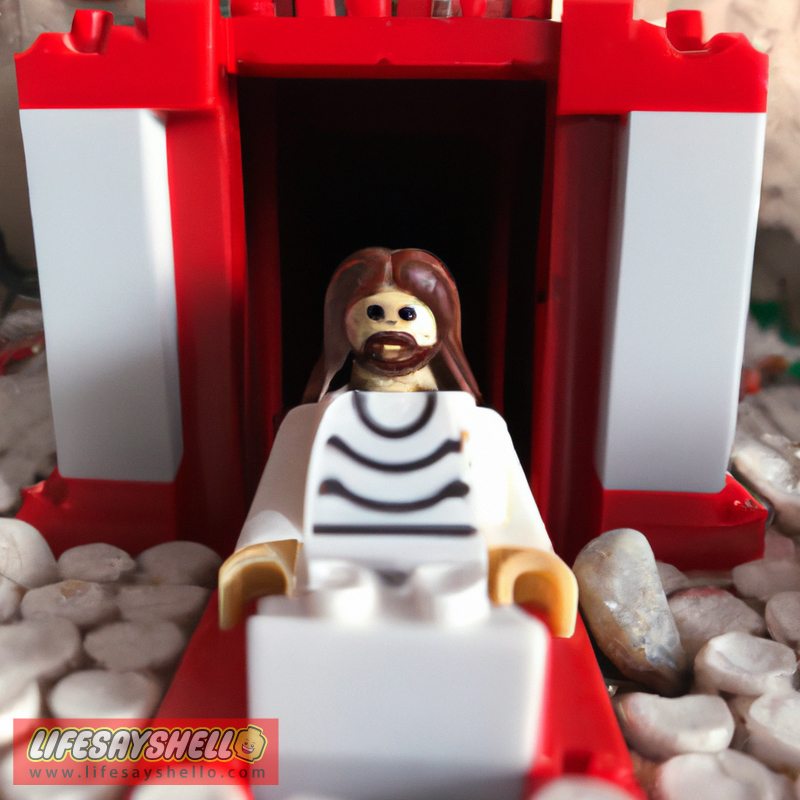Uncovering the Mystery - Where Was Jesus Really Buried?

Have you ever wondered what happened to Jesus Christ after his crucifixion? One of the most debated mysteries throughout history is the question of where Jesus was actually buried and resurrected. The site of Jesus' tomb carries great significance for followers of Christianity. In Jerusalem, several locations claim to be the authentic burial place of Christ. The most famous site is the Church of the Holy Sepulchre in the Old City. However, over the centuries skeptics have proposed other possible tombs in and around Jerusalem. Examining the history and significance of these sites can help shed light on the enduring mystery of where Jesus was laid to rest.
The Church of the Holy Sepulchre - The Traditional Burial Site
The Church of the Holy Sepulchre is a sprawling church built in the Christian Quarter of Jerusalem's Old City. According to ancient tradition, this church was constructed on the location where Jesus Christ was crucified, buried, and resurrected. The Church of the Holy Sepulchre has been venerated as the holiest site for Christians since the 4th century CE.
For centuries, the Church of the Holy Sepulchre has been considered the primary location where the passion, crucifixion, burial, and resurrection of Jesus Christ took place.
The original church was commissioned by Emperor Constantine and inaugurated in 335 CE. Constantine directed builders to construct the church on top of the rocky knoll where Jesus was crucified and buried. This spot was identified by Constantine's mother, Helena, during her pilgrimage to the Holy Land. The Church of the Holy Sepulchre has been built, destroyed, and rebuilt several times throughout its history. The current structure largely dates to the 12th century after Jerusalem's conquest by the Crusaders.
Inside the dimly-lit, ornate church, two sites draw the most interest from pilgrims and tourists. The first is the Stone of Anointing, a reddish slab of rock just past the entrance where it is believed Jesus' body was anointed and wrapped in a burial shroud after being removed from the cross. Visitors kneel at this stone to touch it and say prayers. Just a short distance away is the Aedicule, a shrine encasing the tomb where Jesus was buried and resurrected. This rock-cut tomb has been covered in marble and crowned with a domed structure. Millions flock here to see the tomb and touch its cool stone surface.
For followers of Christianity, the Church of the Holy Sepulchre represents the holiest place on Earth. Its status as the site of Jesus' crucifixion and resurrection has been accepted for 1600 years. Six different Christian denominations control various sections of the church under a fragile power-sharing agreement. Despite occasional squabbles between clerics, daily worship services continue nonstop at the site. For pilgrims visiting Jerusalem, a visit to the Church of the Holy Sepulchre to walk in Christ's footsteps is the ultimate spiritual experience. The church's authenticity as the true site of these events has been debated but never definitively disproven over the centuries.
Challenging the Traditions - Other Proposed Burial Sites
Despite the primacy of the Church of the Holy Sepulchre, skeptics over the years have put forth other sites around Jerusalem as possible burial places of Jesus. Other tombs discovered in the city have been touted as potentially being the "real" site of Jesus' burial and resurrection. While none have managed to significantly challenge the status of the Church of the Holy Sepulchre, they provide interesting food for thought.
The most well-known alternative site is The Garden Tomb, located just outside the Old City walls near the Damascus Gate. This ancient rock-cut tomb was unearthed in 1867 during excavations by British explorers. The tomb featured a large stone which could be rolled across the entrance, consistent with Gospel descriptions of Jesus' burial. Additionally, the surrounding garden contained an ancient cistern hewn from rock and a rocky knoll reminiscent of Golgotha, the "Place of the Skull."
In the late 19th century, this site was promoted by British General Charles Gordon as a possible alternative to the Church of the Holy Sepulchre. Gordon and other Protestants were skeptical of the crowded Holy Sepulchre Church and preferred a more serene, garden-like setting for Jesus' burial. Since Gordon's proposal, The Garden Tomb has been maintained as a peaceful, contemplative site with a Protestant orientation. Though it lacks historical evidence, its ambience leads many pilgrims to favor it as the genuine place of the Easter story.
Another contender was put forth in the 1980s with The Talpiot Tomb, an ancient burial cave discovered during construction in Jerusalem's Talpiot neighborhood. Archaeologists found ossuaries inscribed with several Biblical names like Joseph, Mary and Jesus. The unusual clustering of these famous names led some to theorize this could have been the family tomb of Jesus. Statistically though, the names were very commonplace during that era. Most scholars dismiss the tomb as merely coincidental, belonging to different people with the same names. Though tantalizing, no solid evidence ties The Talpiot Tomb directly to Jesus of Nazareth and his family.
The allure of discovering Jesus' "real" tomb continues to inspire debate and speculation to this day. It speaks to the deep spiritual meaning placed upon the final resting place of Christ.
The Search Continues for Definitive Proof
To this day, no archaeological evidence or scientific techniques have been able to definitively prove or disprove the claim of the Church of the Holy Sepulchre to be the authentic site of Jesus' crucifixion, burial and resurrection.
The lack of consensus stems from several factors. The first is the destruction and rebuilding of the church several times over the centuries, erasing much of the original site's history. Secondly, the tomb itself was cut from rock and left no bodily remains or artifacts which could be analyzed with modern forensic tools. Lastly, the chaotic history of Jerusalem's conquest by Romans, Arabs, Crusaders and others caused many important records to be lost or destroyed forever.
Despite the absence of smoking gun proof, the Church of the Holy Sepulchre retains its preeminent status for most Christian denominations. The sites of the Crucifixion and the tomb at the church are consistent with the Biblical accounts and match local traditions dating back to the 4th century when Constantine commissioned the first church. Skeptics over the years have failed to present a theory strong enough to topple the accepted traditions surrounding the Holy Sepulchre.
For archaeologists and historians, the search continues for any evidence which might shed further light on the location of Jesus’ death and burial. Advancements in technology and new discoveries provide hope that more clues may surface. Most recently, the use of 3D laser scanning allowed researchers to reconstruct and study key areas within the Church of the Holy Sepulchre without physically damaging the site. Ongoing exploration of ancient tunnels and cisterns beneath Jerusalem occasionally uncovers artifacts from the 1st century AD when Jesus lived.
The lure of unraveling the true story of Jesus’ crucifixion and resurrection will likely inspire many more theories and continued research. For Christian pilgrims visiting Jerusalem today however, the Church of the Holy Sepulchre remains the preeminent sacred destination. The church has withstood sceptics, calamities, conflicts and the test of time to stand today as the holiest physical reminder of the death and resurrection of Jesus Christ. Though its origins remain clouded in mystery, the Church of the Holy Sepulchre endures as a living monument to the foundation of Christian faith for millions of believers worldwide.
Preserving Precious History While Allowing Access
The Church of the Holy Sepulchre presents a unique challenge of accommodating millions of annual visitors while preserving fragile antiquities. As the prime pilgrimage location for multiple Christian denominations, crowds are inevitable. But steps have been taken to protect sensitive areas from excessive wear and tear.
For example, access to the Edicule shrine containing the tomb of Christ is carefully managed. Queues form allowing people to briefly enter the shrine and touch the reddish slab encasing the tomb where Jesus' body was laid. Guards keep visitors moving at a steady pace and discourage any who linger too long.
The Stone of Anointing also attracts long lines as pilgrims kneel and reach out to touch its smooth surface. Clergymen stand watch ready to admonish anyone who behaves inappropriately. Signs remind visitors that no religious artifacts or materials may be left behind on the stone. Preservation of the sacred stones requires gently balancing reverence and decorum with crowd control.
Delicate remnants like the walls of the Catholicon (the main church building) require frequent monitoring. Cracks or instabilities in the ancient stonework are identified and mended by experts. Other areas of the church undergo periodic refurbishment and cleaning to maintain their awe-inspiring presence. The Dome of the Katholicon, for example, gleams with restored gold mosaic dating to the Crusader era.
Perhaps the greatest achievement is the recent restoration of the Edicule itself. In 2016, the shrine underwent a meticulous renovation. Decades of candle soot and grime were removed to uncover the original reddish hue of the limestone tomb. The unstable concrete encasing the tomb was refurbished and replaced with sturdy mortar. The $4 million dollar restoration was a model of interdenominational cooperation between the Greeks, Armenians and Catholics who share custody of the Edicule.
Preserving the Church of the Holy Sepulchre is a monumental undertaking but critical to allow continued access to its holy sites. The structural integrity and cleanliness of the church is testament to the shared devotion of its custodians. Through careful conservation practices, the ancient sanctuary continues welcoming millions of pilgrims to walk in Christ's footsteps.
The Enduring Allure of the Church of the Holy Sepulchre
Why does the Church of the Holy Sepulchre continue captivating visitors after 16 centuries? What drives Christians from all corners to make pilgrimage to its stone-walled sanctuaries? The church's mysterious origins and rich history are only part of its allure. Its enduring magnetism also stems from the sense of transcendence attained by coming to the perceived sites of the Passion and Resurrection.
Stepping inside the church transports one back in time. The rows of sooty hanging lamps, faded frescoes and hushed chanting create an atmosphere heavy with reverence. Millions have come seeking inspiration in these stones - Byzantine pilgrims, Crusader knights, Syrian monks and more. In a city torn by conflict, this sacred space rose time and again, stubbornly clinging to its holy purpose.
Many come not just to see artefacts, but to bridge a spiritual divide. Kneeling before the Stone of Anointing or entering the somber Edicule, one relives an ancient narrative. For an instant, centuries vanish as past and present converge. Through Christ's anguish and ultimate triumph here, many draw hope and strength for their own trials.
Jerusalem's urban clamor fades upon entering the church's cool, dimly-lit interior. Its ornate chapels and processions inspire reflection on matters beyond the mundane. Attending Mass, one feels linked to the unbroken stream of worshippers who echoed these same chants and rituals. In this storied corner of the Holy Land, tales of prophets and kings come alive. Prosaic worries give way to contemplation of the divine.
Perhaps this is the Church of the Holy Sepulchre's greatest power - its transcendence of time and suffering to evoke the sacred. Through art, architecture, and aura, it becomes more than a historic site. For pilgrim and pastor alike, this holy shrine will continue nourishing faith and providing fleeting glimpses of the divine.
Conclusion
The mystery of Jesus' burial place has puzzled scholars and enticed pilgrims for centuries. Several sites around Jerusalem claim to be the tomb of Christ, but none possess definitive proof. The Church of the Holy Sepulchre stands alone as the site revered since ancient times as the location of Jesus' crucifixion and resurrection. While debates persist over its contested history, the church remains a unique sanctuary at the heart of Christianity.
Within its weathered walls, flickering lamps still guide the prayers of worshippers from around the globe. Echoes of ancient chants endure alongside modern hymns. The church has survived every upheaval in Jerusalem's history and endures today as living testament to an ancient faith. For the millions drawn to walk in Christ's final footsteps, the Church of the Holy Sepulchre retains its sacred allure across the centuries. No matter one's beliefs, all can appreciate how this holy place at the center of the Christian world continues bringing spiritual sustenance to pilgrims after 1600 years. Its ability to transcend time and tribulation affirms its status as the preeminent physical reminder of the death and resurrection of Jesus Christ.




Comments